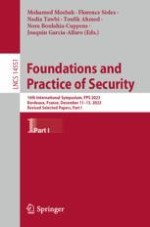2024 | OriginalPaper | Chapter
Original Entry Point Detection Based on Graph Similarity
Authors : Thanh-Hung Pham, Mizuhito Ogawa
Published in: Foundations and Practice of Security
Publisher: Springer Nature Switzerland
Activate our intelligent search to find suitable subject content or patents.
Select sections of text to find matching patents with Artificial Intelligence. powered by
Select sections of text to find additional relevant content using AI-assisted search. powered by
